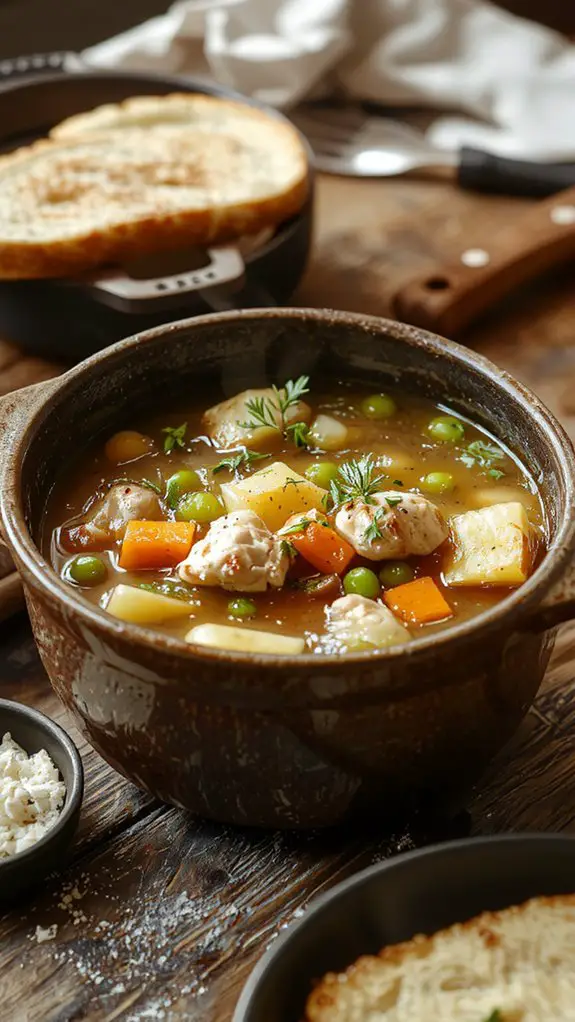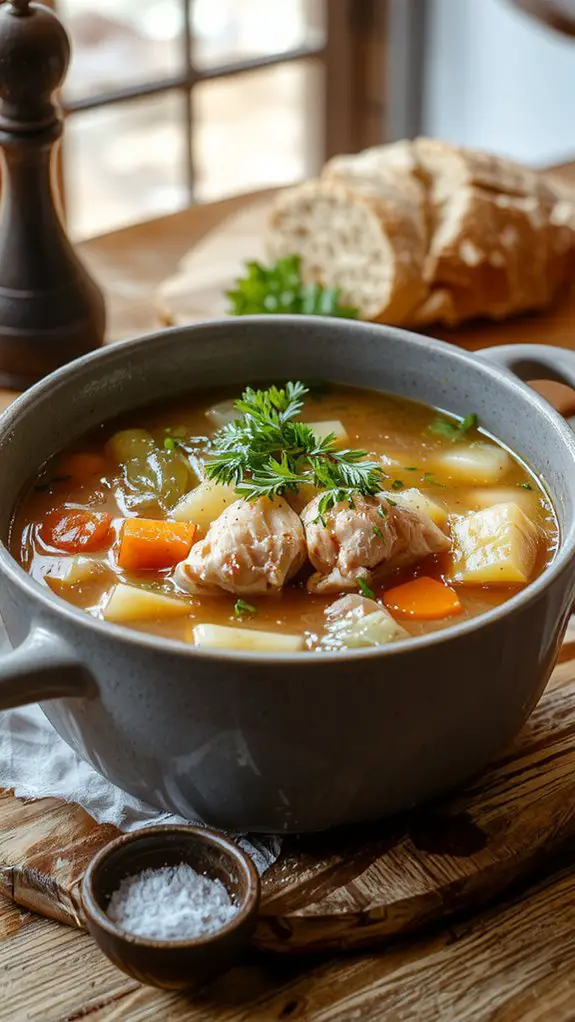There’s something deeply comforting about a bowl of homemade chicken stew on a chilly day. I’ve spent years perfecting a recipe that balances tender chicken, hearty vegetables, and a rich, flavorful broth. It’s not just about tossing ingredients into a pot; it’s about layering flavors and letting them meld together. If you’re curious about how to elevate this classic dish, the answer lies in a few simple techniques and ingredients.
Recipe
If there’s one recipe that always feels like a warm hug on a chilly day, it’s this homemade chicken stew. I’ve made this countless times, and I can confidently say it’s the coziest, most satisfying dish you’ll ever whip up in your kitchen.
What sets it apart? Tender chunks of chicken, hearty vegetables, and a rich, velvety broth that’s packed with flavor—thanks to a secret blend of herbs and a splash of white wine.
It’s the kind of meal that fills your home with an aroma so inviting, even your neighbors might come knocking. Whether you’re cooking for a crowd or just craving something comforting, this stew is foolproof and absolutely worth the effort.
Trust me, one bite and you’ll understand why this is my go-time recipe.
Ingredients
Start with fresh, high-quality ingredients to build layers of flavor in this comforting chicken stew. Opt for bone-in chicken pieces for richer broth, and don’t shy away from hearty vegetables like carrots and potatoes—they’ll soak up all the savory goodness. Here’s what you’ll need:
For the base:
- Bone-in chicken thighs or drumsticks (or a mix) – The bones add depth to the broth. Sub with boneless thighs if preferred, but reduce cooking time.
- Chicken stock (low-sodium) – Homemade stock is ideal, but store-bought works too. Add a splash of white wine for extra depth if you’re feeling fancy.
- Olive oil or unsalted butter – For sautéing. Butter adds richness, but oil is great for a lighter touch.
For the aromatics:
- Yellow onion – Diced for sweetness. Red onion can sub in a pinch.
- Garlic cloves – Minced. Don’t skimp—fresh garlic is non-negotiable for that robust flavor.
- Carrots – Chopped into coins. They add natural sweetness and color.
For the bulk:
- Yukon Gold potatoes – Diced. Their creamy texture holds up well in stews. Russets work too, but they’ll break down more.
- Celery stalks – Chopped. Essential for that classic savory base.
For seasoning and finishing:
- Bay leaves – Remove before serving; they’re a must for that herby, earthy note.
- Dried thyme or fresh thyme sprigs – Fresh thyme is ideal, but dried works if that’s what you have.
- Paprika (smoked or sweet) – Adds warmth and depth. Smoked paprika gives a subtle smoky kick.
- Salt and black pepper – Season to taste, but go easy on the salt if using store-bought stock.
Optional but worth it:
- Frozen peas – Stir in at the end for a pop of color and sweetness.
- Fresh parsley – Chopped and sprinkled on top for a bright finish.
Pro tip: If you want to thicken the stew, mash a few potato pieces against the side of the pot or mix in a tablespoon of flour or cornstarch slurry. This stew is all about flexibility, so feel free to make it your own!
How to Make the Best Classic Chicken Stew Title

- Heat olive oil in a large pot over medium heat. This guarantees the oil is ready to sear the chicken without burning.
- Season chicken thighs with salt and pepper generously. This creates a flavorful base for the stew and enhances the chicken’s natural taste.
- Sear the chicken for 4-5 minutes per side until golden brown. Don’t overcrowd the pot—do this in batches if needed. The caramelization adds depth of flavor.
- Remove the chicken and set aside. This stops overcooking while you prepare the vegetables.
- Sauté onions, carrots, and celery in the same pot for 5-7 minutes until softened. Use the residual flavor from the chicken for added richness.
- Add garlic and cook for 1 minute until fragrant. Garlic burns quickly, so keep an eye on it to avoid bitterness.
- Stir in tomato paste and cook for 2 minutes. This intensifies the flavor and gives the stew a robust base.
- Deglaze the pot with chicken broth, scraping up any browned bits. These bits are packed with flavor and shouldn’t be wasted.
- Add potatoes, thyme, and bay leaves. These hearty ingredients will cook down to create a comforting texture.
- Return the chicken to the pot and bring to a simmer. Letting it simmer secures the chicken becomes tender and the flavors meld.
- Cover and cook on low heat for 30-40 minutes until the chicken is cooked through and vegetables are tender. Avoid boiling to keep the chicken juicy.
- Taste and adjust seasoning with salt and pepper. Stews often need a final touch to balance flavors.
- Remove bay leaves before serving. They’re not edible and can be a choking hazard.
- Garnish with fresh parsley for a pop of color and freshness. This adds a bright finish to the rich stew.
- Serve hot with crusty bread or rice for a complete meal. The bread soaks up the delicious broth perfectly.
- Store leftovers in an airtight container in the fridge for up to 3 days or freeze for up to 3 months. Stews often taste even better the next day!
Nutrition
Homemade chicken stew offers a comforting and nutritious meal. Below is the nutritional breakdown per serving.
| Nutrient | Amount |
|---|---|
| Calories | 320 kcal |
| Protein | 25 g |
| Fat | 12 g |
| Carbohydrates | 25 g |
| Fiber | 4 g |
| Sugar | 5 g |
| Sodium | 800 mg |
Chef Tips
When preparing chicken stew, I always recommend browning the chicken pieces first to deepen the flavor of the broth. Don’t skip sautéing the onions, carrots, and celery—they create a rich base.
Use homemade or high-quality stock for better taste. Simmer gently to keep the chicken tender and let the flavors meld. Taste and adjust seasoning at the end, and finish with fresh herbs for brightness.






